Famalicão have been a wonder-story this season in the Liga NOS. Having just been promoted this season, they signed 19 new players in the summer, including Gustavo Assuncao, and 10 on loan, including Atletico Madrid’s Nehuen Perez. No doubt owner Omer’s relationship with superagent Jorge Mendes has helped with this summer spending spree which saw Famalicão get off to a flying start, including being at the top of the league by matchweek seven. Despite currently being in seventh place, Famalicão have definitely made a statement of intent to challenge the top 4 (Porto, Benfica, Sporting and Braga).
In this tactical analysis, we will be going over the tactics used by Famalicão this season, looking at how they integrated 19 new players into the team, and where they still need to improve to provide a serious threat to the top 4.
The success of centralised attacks
Famalicão this season have undoubtedly been most successful in their attack, having scored 37 times this season, good enough for fifth in the league in terms of goals scored. The way they have looked to attack has often been through central areas, using the fullbacks to stretch the opposition before feeding the ball back inside. The following graphic shows how Famalicão often progressed the ball, which shows how they used balls to the fullback to “bait” the opposition and create space in more desirable central areas.
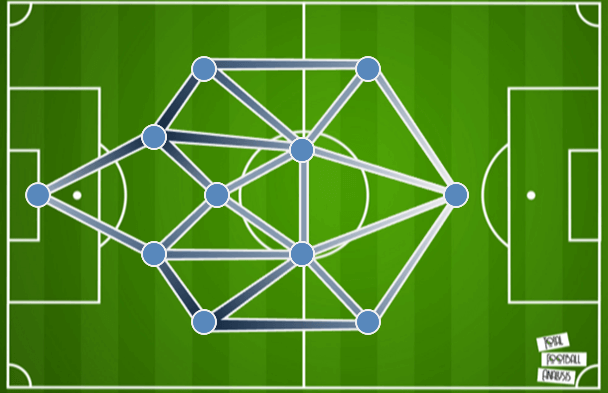
If we look at an in-game example of this happening, we see the fullback who is in possession after the central defender plays the ball to him.
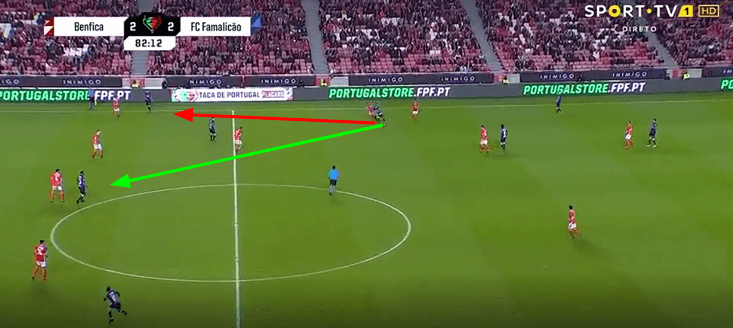
He has then found himself in a situation in which he can play the ball centrally or out wide. Both the central player, Toni Martinez, and the winger, Diogo Goncalves are equally supported, so it is a matter of tactical preference. The ball is played by the fullback to Martinez, as shown by the green arrow. The frequency of this happening was high, thus providing an explanation as to why the fullbacks are statistically the most common progressors of the ball. Looking at left-back Alex Centelles’ ball progression map, we see a similar story with the number of progressive passes inwards.
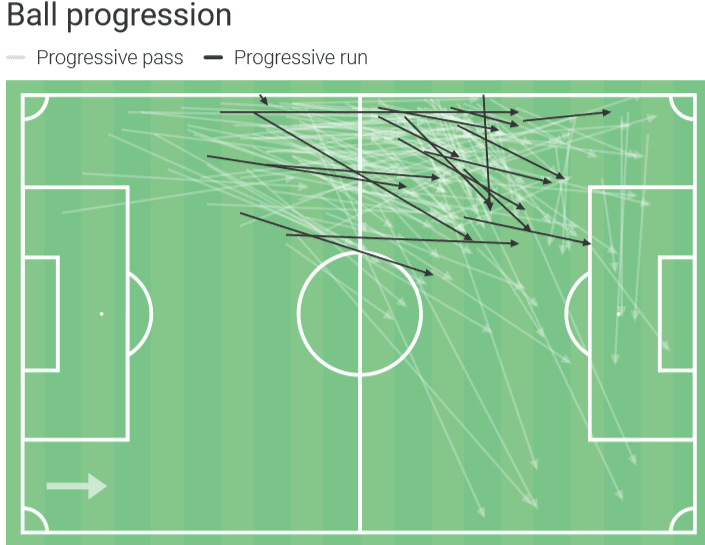
However, when the ball to the defensive midfielder (usually new signing Assuncao), the ball would immediately go to him, as is shown below.
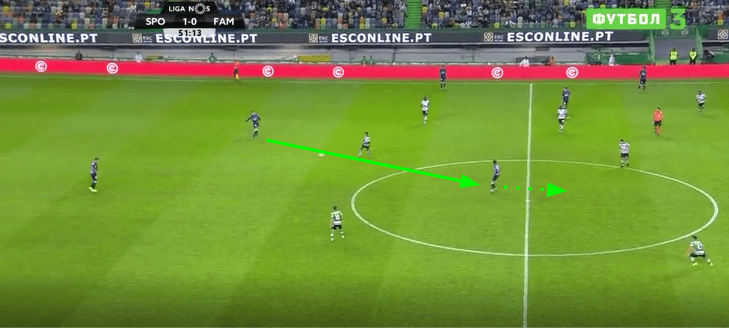
Assuncao would then turn and look to play the ball vertically as opposed to horizontally to the wingers or fullbacks. The pass would usually be towards Martinez, who was also often close to the right-winger, Pedro Goncalves.
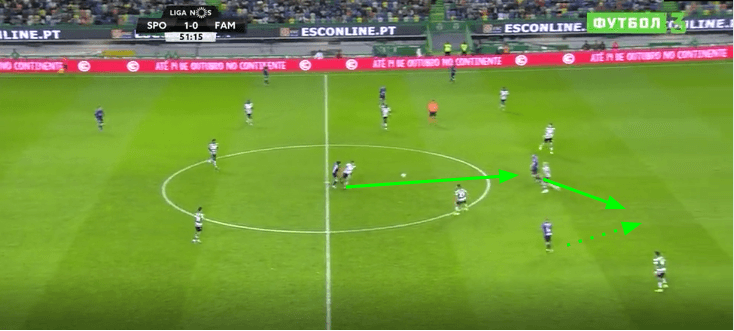
This situation above shows the usual structure of Famalicão in attack. Left-central midfielder Pedro Goncalves would push up from the three-man midfield, meaning left-winger Fabio Martins was deeper in the build-up. This structure is visible in the average position map from Famalicão vs Sporting, shown below.
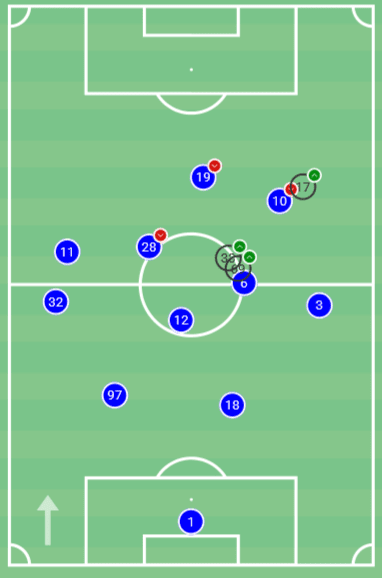
Now moving onto the success of such build-up and attack, firstly a radar for Famalicão’s offensive output will be presented, showing a statistical comparison of offensive stats between Famalicão and the rest of the league.
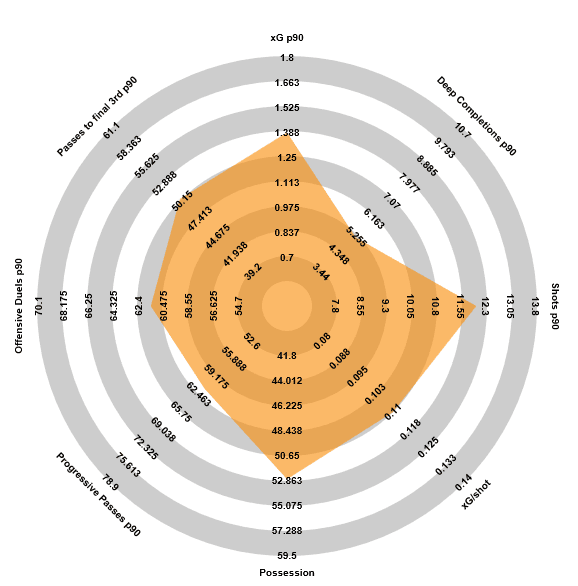
In terms of progression, Famalicão do not rank particularly high, which is a stylistic indicator more than anything. With progression, as shown in the situation with Assuncao, Famalicão looked to play as few passes as possible. The passes from the centre-back and defensive midfielder were the two main progressive passes, so a team which looks to play out of the back in a more aesthetically pleasing manner may rank high, but they may be less effective during the build-up. This tactical style also provides an explanation as to why Famalicão do not make as many passes into the final third despite boasting good goal-scoring and final third metrics.
Defensive frailties
Moving on now to where Famalicão have often looked the most disappointing, defensively. Despite positively standing out in the goal-scoring department, Famalicão negatively stood out defensively, conceding the second-highest number of goals this season (40). Let’s first break down statistically where Famalicão have suffered most, using a defensive radar.
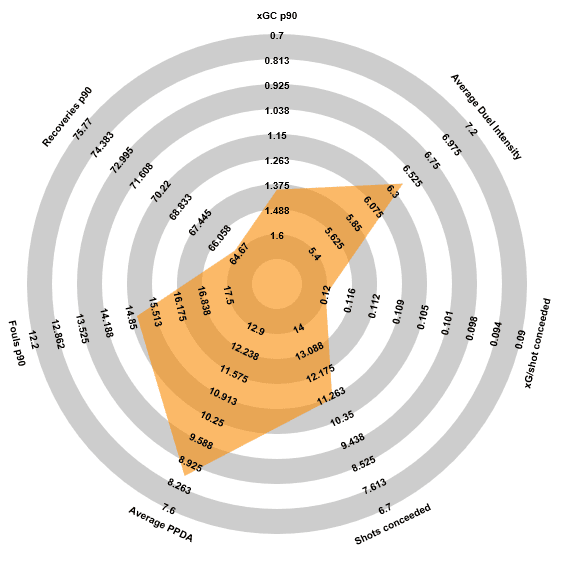
Two areas stand out immediately: expected goals per shot conceded and the number of recoveries made per 90 minutes. One conclusion this leads us to is that Famalicão are not making recoveries in key areas, allowing opposition teams to get through the mid-block and create chances. These also tend to be high-quality chances, as shown by the expected goals per shot conceded being a high number. This could be because, after a failed recovery, Famalicão are forced onto the back foot and thus the defenders, many of whom have not even been playing with their teammates for a year, make mistakes resulting in the high-quality chances conceded.
Let’s take a look at how Famalicão set up their mid-block, and if there are any noticeable points of weakness.
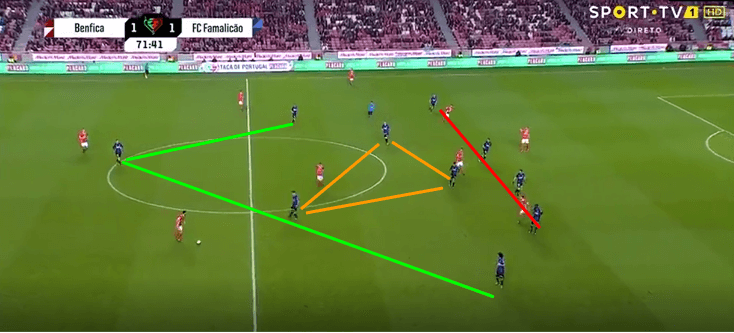
Unlike most teams across Europe, Famalicão maintain the same structure defensively as they do offensively. That is to say, the left central midfielder pushes slightly further up, the left-winger drops deeper, and the right-winger pushes further up towards the striker.
What this means is that there are often gaps left behind the left-central midfielder when he steps up which can easily be exploited and used to vertical progression by the opposition’s right-sided midfielder. And so, when the left-central midfielder cannot retreat to regain possession from the man in behind him, the opposition not only have a numerical advantage in a dangerous area, but also are causing the defenders of Famalicão to potentially make rash decisions. This is bound to happen when you have developing talents like Nehuen Perez in the team, who might not have the composure or experience to deal with the threat.
Whilst at first, the solution may seem as simple as dropping the left-midfielder deeper, and perhaps forming a lower block, the midfielder is kept higher for a reason. This allows him to drive forward and lead the counterattacks when Famalicão defensive players win the ball back. This risk vs reward strategy has often led to goals on the counter, as will be discussed later, but has undoubtedly cost Famalicão more than they have scored. To maintain this attacking threat whilst tightening up the defence, Famalicão could potentially move to a 4-2-3-1 and allow the attacking midfielder freedom to roam. This would leave the other two midfielders to handle the space behind him more evenly, thus preventing dangerous scenarios as described ensuing.
Structured transitions
As with their defensive and offensive style, Famalicão like to have structure when counterattacking. Usually, this will be the same as both of the two phases mentioned, with the central midfielders pushing up, the striker veering to the right and the winger supporting. This can be seen in the situation below, in which Famalicão have started their counterattack after a long pass from the goalkeeper.
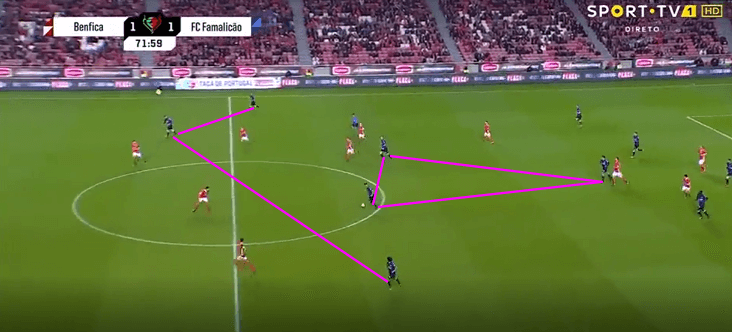
The most common route during the counterattacks was that the two wingers and the spare midfielder would make dummy runs into space to either provide themselves as an option or look to take players away from the striker Martinez. This would open up a passing lane for the man in possession, who could thread a through pass to the striker, as shown below.
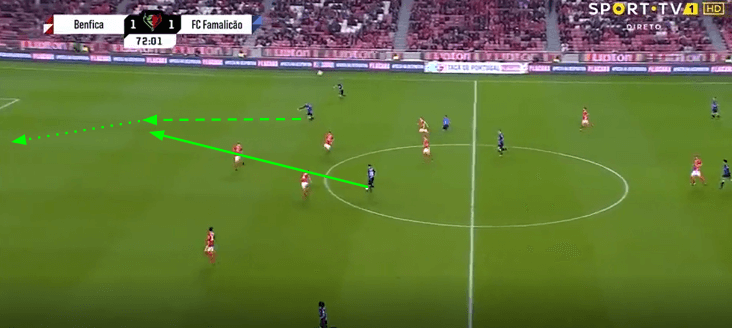
After having played the ball in front of him, a similar scenario as before would ensue with players making summy runs: one to the front post, one towards the back, and one to the edge of the box in an attempt to create an opportunity or space. On the back of this, in the scenario above, Martinez is allowed to roam towards the edge of the box before slotting his shot into the bottom corner.
Across this scenario, we have seen what was spoken about earlier with Famalicão leaving one of the midfielders further up to carry the counterattack and have seen the reward aspect of this. Where Famalicão might look for inspiration into how to maintain this transitional threat is Benfica, who have a similar setup with their wingers, but often use second striker Chiquinho to drop deeper and carry forwards the ball whilst being supported by Taarabt or Pizzi. This provides a good basis for how to maintain balance in a counter, whilst also not leaving yourself too compromised if the counterattack fails.
Conclusion
Throughout this analysis, we have looked at how Famalicão have found success offensively, how they look to transition and make the best of opportunities on the counter and what has led to them losing out to the big four this season, their defence. On the whole, Famalicão have definitely shown intent. Not even the most optimistic of their fans would have thought they would be seventh at this point in the season.
However, the defensive structure needs improving as soon as possible. One has to question whether they can just sign more players without considering squad cohesion. Jorge Mendes might have to slow down as Famalicão look to break the streak of consistent title wins between Porto, Benfica and Sporting, and become the newest big team, in Portugal.

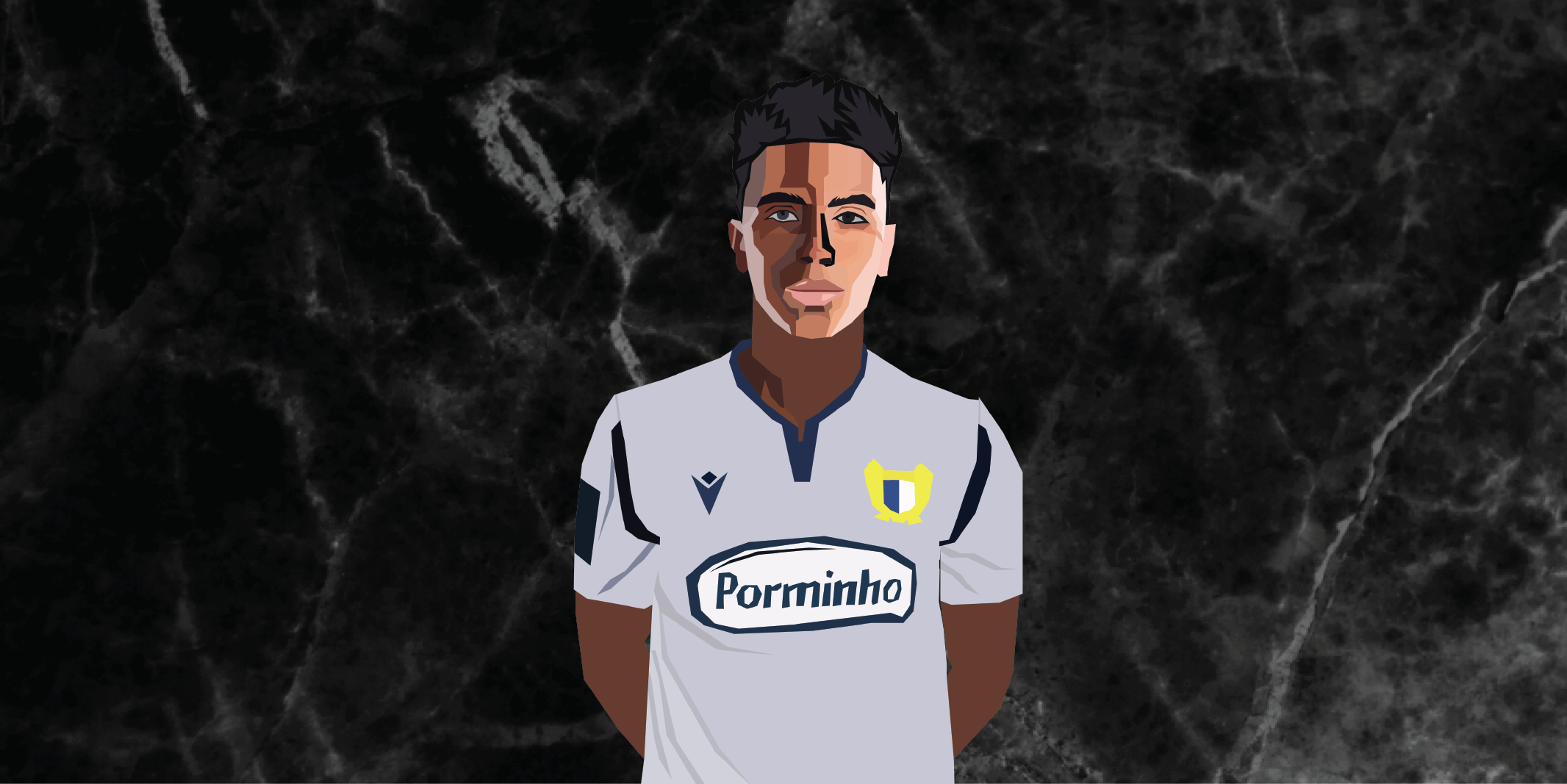



Comments